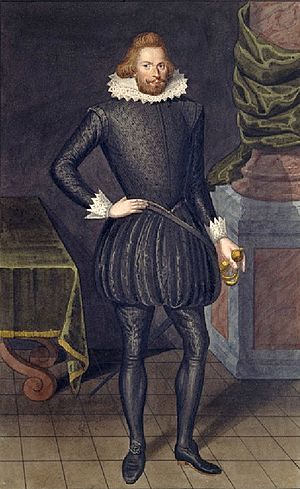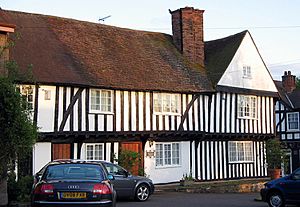Everard Digby facts for kids
Quick facts for kids
Sir
Everard Digby
|
|
|---|---|

Portrait of Digby
|
|
| Born | c. 1578 |
| Died | 30 January 1606 (aged 27–28) Westminster, London, England
|
| Spouse(s) | Mary Mulsho |
| Children | Kenelm Digby, John Digby |
| Parent(s) | Sir Everard Digby Maria Neale |
| Motive | Gunpowder plot, a conspiracy to assassinate King James VI & I and members of the Houses of Parliament |
| Conviction(s) | High treason |
| Criminal penalty | Hanged, drawn and quartered |
| Role | Uprising |
| Enlisted | 21 October 1605 |
|
Date apprehended
|
8 November 1605 |
Sir Everard Digby (born around 1578 – died January 30, 1606) was part of a group of English nobles. They planned the famous, but failed, Gunpowder Plot in 1605. Even though he grew up in an Anglican family and married a Protestant, Everard and his wife secretly became members of the Catholic Church in England. At that time, being Catholic was against the law. A Jesuit priest named John Gerard helped them convert.
In the autumn of 1605, Everard Digby went on a religious trip to a holy place called St Winefride's Well in Holywell, Wales. Around this time, he met Robert Catesby. Catesby was planning to blow up the House of Lords using gunpowder. His goal was to kill King James I and other important people in the government. Catesby then wanted to start a rebellion to put a Catholic ruler on the English throne.
We don't know exactly how much Everard Digby knew about the plot. But Catesby asked him to rent Coughton Court and prepare a "hunting party." This party was actually a group of armed men ready for the planned uprising. However, the plot failed. Digby joined the other plotters as they tried to escape through the Midlands. They couldn't find anyone to support their cause. Digby left the other fugitives at Holbeche House in Staffordshire. He was soon caught and taken to the Tower of London.
Digby was put on trial on January 27, 1606. He tried to defend himself well, but he was found guilty of high treason. Three days later, he was executed.
Contents
Everard Digby's Early Life
Everard Digby was the oldest son of Everard Digby, Esquire, and Maria Neale. His family came from Leicestershire. He was a cousin of Anne Vaux, who often helped hide Jesuit priests like Henry Garnet.
In 1596, when he was still a teenager, Everard married Mary Mulshaw. She was a young heiress who owned Gayhurst House in Buckinghamshire. Their marriage was said to be a happy one. They had two sons, Kenelm Digby, born in 1603, and John, born in 1605.
Unlike some other English Catholics, Digby didn't have much experience with the laws against Catholics. After his father died, he was placed under the care of the court. He was raised in a Protestant home. His wife, Mary, became Catholic with the help of the Jesuit priest John Gerard. When Digby became very ill, Gerard also helped him convert. They became close friends, even calling each other "brother." Gerard was the godfather to Digby's oldest son, Kenelm. The Digbys also built a secret chapel at Gayhurst.
Digby often visited the court of Queen Elizabeth I. He was informally connected with the Queen's special guards. His marriage greatly increased his land and wealth. Because of this, he left court to manage his properties. On April 24, 1603, he was made a knight by King James I at Belvoir Castle. This happened a month after Queen Elizabeth's death. Four days later, he attended Elizabeth's funeral in London.
Meeting Robert Catesby
In late August or early September 1605, Digby, his wife Mary, and their secret Jesuit chaplain Edward Oldcorne went on a religious trip. This trip was organized by Henry Garnet and Anne Vaux, among others. They started from White Webbs and headed to St Winefride's Well in Holywell. Along the way, more people joined them.
When the group of about thirty pilgrims returned from Holywell in mid-September, they stopped at Digby's home at Gayhurst. On October 21, Digby, his wife Mary, Garnet, and Vaux were celebrating a holiday at Harrowden. While there, he met Robert Catesby. Catesby asked Digby to promise to keep a secret before telling him about what became known as the Gunpowder Plot.
English Catholics had hoped that King James I would be more tolerant towards them. However, Catesby felt that James had broken his promises. So, Catesby planned to kill James by blowing up the House of Lords with gunpowder. He then wanted to start a revolt to bring a Catholic ruler back to the throne. Catesby had already gathered other Catholics, but he was running out of money. So, the group decided to get more people involved. Catesby had recruited Ambrose Rookwood, a rich Catholic, and his wealthy cousin, Francis Tresham.
We don't know how much Digby knew about the plot. But author Alan Haynes believes Digby was shocked by what he heard. He asked what would happen to their Catholic friends. Catesby replied that important nobles would be saved and wouldn't know about the plan. He also lied to Digby, saying that the Jesuits approved of the action. Catesby then told Digby to rent Coughton Court. From there, Digby was to organize a "hunting party." This party was actually a group of armed men ready for a military action. Digby also promised to give £1,500 to help with the plot's costs.
The Hunting Party and the Plot's Failure
On November 2, at Gayhurst, Digby was preparing for his hunting party when Gerard visited him. Gerard noticed the house was almost empty. He asked Digby if something was happening and if Garnet knew about it. Digby didn't want to involve Gerard, so he said he knew nothing. Gerard later regretted not having the chance to stop Digby.
Two days later, Digby and his servants were at the Red Lion inn in Dunchurch. This was where his hunt was supposed to take place. Other people were there, including his uncle, Sir Robert Digby. They had supper and were later joined by fellow plotter John Grant.
Around midnight on November 4, Guy Fawkes was found guarding the gunpowder under the House of Lords and was arrested. The plotters still in London quickly fled to the Midlands. They met Digby and his group at Dunchurch. Catesby told Digby that the king and Salisbury were dead. He said that if Catholics acted now, they could get good conditions for themselves. Digby was convinced, but many in his group were upset. They felt tricked and didn't want to be involved in treason.
The Escape and Capture
On November 6, the fugitives raided Warwick Castle to get more horses. They then went to Norbrook to get weapons. From there, they continued to Huddington. Catesby sent a letter to Father Garnet at Coughton Court. Catesby and Digby asked Garnet to forgive their actions and help them raise an army in Wales. Garnet replied, asking them to stop their "wicked actions" and listen to the Pope's teachings.
With fewer and fewer supporters, the remaining fugitives arrived at Huddington around 2:00 PM. They had hoped for support, but almost everyone they met was only worried about their own safety. The next morning, they rode through the rain. They stopped briefly to take supplies from Lord Windsor's home at Hewell Grange. Still, the local people refused to help them. Digby later said that "not one man" joined them. That night, they arrived at Holbeche House on the border of Staffordshire. They were tired and desperate. They spread out some of the wet gunpowder in front of the fire to dry it. A spark from the fire landed on the powder, and the flames burned Catesby, Rookwood, Grant, and another man.
Catesby and fellow plotters Thomas Percy, John Wright and his brother Christopher were killed by the Sheriff of Worcester's men on November 8. But Digby had already left to surrender himself. He was the only plotter to do so. With two servants, he hid in nearby woods. Their tracks were soon found. Digby gave himself up to the most senior-looking person he found.
While Digby was taken to the Tower of London, his home at Gayhurst was searched. Servants' belongings were stolen, and animals were sold cheaply. Mary Digby was left without money. At the Tower, Digby's clothes were searched, and money was found. William Waad, the Lieutenant of the Tower, asked to use some of the money for Digby's food and bedding.
Digby tried to meet with King James to explain himself, but he was unsuccessful. While imprisoned, he wrote secret letters that were smuggled out of the Tower. He described how he refused to cooperate with his questioners. Digby also carved a message on his cell wall, which can still be seen today.
In December 1605, Mary Digby wrote to the Earl of Salisbury. She complained that their house had been stripped of belongings. She asked for her husband's life and for the King's help.
Trial and Execution
Digby was tried on the same day as seven other surviving plotters. This happened in Westminster Hall on Monday, January 27, 1606. The king and his family watched secretly as the charges against the plotters were read. Digby was the only one to plead "Guilty." He was tried separately.
Dressed in a black satin suit, he gave a short and emotional speech. He defended his actions by explaining his loyalty to Catesby and his religious beliefs. He accused King James of breaking promises of tolerance for Catholics. He also spoke of his fears of harsher laws against Catholics. He asked that his family not be punished for his actions. Finally, he asked to be beheaded instead of the more severe punishment. His words were mostly ignored. The prosecution criticized James's supposed broken promises and made fun of Digby for asking for mercy. Along with the other plotters, he was found guilty. As they were led from the hall, Digby said, "If I may but hear any of your lordships say, you forgive me, I shall go more cheerfully to the gallows." The reply came back, "God forgive you, and we do."
He spent his last few days in the Tower writing letters to his wife and sons. He urged his sons to avoid bad examples.
Digby was executed early on Thursday, January 30. Many people watched as he was tied to a wattled hurdle. He was then dragged by horse to the western end of Old St Paul's Cathedral churchyard. Armed guards were along the route to prevent any rescue attempts. Digby was the first of the four men to face the executioner. He climbed the scaffold and spoke to the crowd. He said he knew he had broken the law, but that in his religion's eyes, he had done nothing wrong. He asked for God's forgiveness and the country's. He also said that the Jesuits and Father Gerard were innocent. He refused help from a Protestant clergyman and spoke to himself in Latin. Then he said goodbye to his friends.
Digby was then stripped of his clothing, except for his shirt. He murmured, "O Jesus, Jesus, save me and keep me," as he climbed the ladder and was hanged for a short time. The executioner cut the rope, and Digby fell back to the scaffold. Wintour, Grant, and Bates were executed next. The remaining four plotters faced similar fates the next day at the Old Palace Yard in Westminster.
Images for kids




